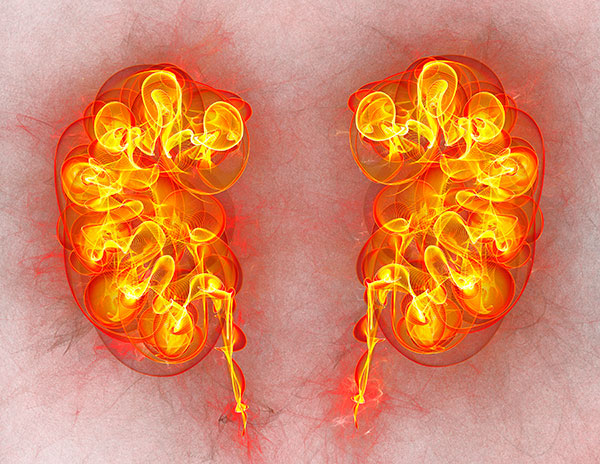Women and female mice are better able to recover from acute kidney injury (AKI) than are men and male mice, but the reasons for this hasn’t been well understood. The results of a murine study led by Duke Health researchers now suggest that females have an advantage at the molecular level that protects them from a form of cell death known as ferroptosis, which occurs in injured kidneys. Their study highlighted the NRF2 antioxidant pathway as the female resilience mechanism against ferroptosis. Headed by Tomokazu Souma, MD, PhD, an assistant professor at Duke University School of Medicine Department of Medicine, the researchers say this protection could be exploited for potential therapeutic purposes in both men and women.
“Kidney disease afflicts more than 850 million people worldwide every year, so it’s important to understand why female kidneys are more protected from these acute and chronic injuries,” said Souma. “Our study is a step toward identifying the causes and suggests that this female resilience could be therapeutically harnessed to improve kidney repair in both sexes.”
Souma and colleagues reported their results in Cell Reports, in a paper titled “Sex differences in resilience to ferroptosis underlie sexual dimorphism in kidney injury and repair,” in which they concluded, “Taken together, our results raise the possibility that NRF2 can be therapeutically harnessed to inhibit ferroptosis in kidneys and thereby improve renal repair and regeneration after injury in both sexes.”
Acute kidney injury is a major health problem that affects 1.2 million hospitalized patients annually in the U.S., the authors noted. “Up to half of these patients fail to undergo renal repair and progress to chronic kidney disease (CKD), a condition associated with significantly increased morbidity and mortality.” Kidney damage is also common in COVID-19 disease, they continued, with up to half of hospitalized patients manifesting AKI, and some surviving patients progressively losing kidney function. There’s an urgent need for new therapeutic approaches, the investigators stated.
There’s increasing evidence that men are disproportionately and more severely affected by AKI than are women, and this includes COVID-19-associated AKI. The team noted that the combined findings from studies in humans and in mice suggest that “elucidating sex-dependent molecular mechanisms underlying resilience to injury will point to new therapeutic approaches.”
Souma and colleagues conducted studies in mice to further investigate a type of cell death called ferroptosis, which has only recently been discovered. This form of cell death is dependent on iron and oxidative stress. It has been identified as a key player in kidney diseases. “Importantly, ferroptosis is emerging as a critical driver of acute and chronic kidney diseases in mice and humans,” they commented.
Using genetic and single-cell RNA transcriptomic analysis in mice, the researchers found that being female confers striking protection against ferroptosis through a molecular pathway called nuclear factor erythroid 2–related factor 2, or NRF2. “We show that PT [proximal tubular] cells in female kidneys are resistant to ferroptosis, whereas male PT cells are vulnerable,” the team noted. “Single-cell transcriptomic analyses further identify the NFE2-related factor 2 (NRF2) antioxidant protective pathway as a female resilience mechanism against ferroptosis.”
In females, the studies showed, NRF2 is highly active, keeping cell death in check. In males, however, the sex hormone testosterone reduces the activity of NRF2, thus promoting ferroptosis and undermining cell resiliency in kidney injury.
Their experiments also showed that chemically activating NRF2 protected male kidney cells from ferroptosis, and so demonstrated that NRF2 could be a potential therapeutic target to prevent failed renal repair after acute kidney injury. The researchers stated, “Importantly, pharmacological NRF2 activation protects male PT cells from ferroptosis and improves cellular plasticity as in females. Our data highlight NRF2 as a potential therapeutic target to prevent failed renal repair after acute kidney injury in both sexes by modulating cellular plasticity … Our genetic loss-of-function and pharmacological gain-of-function studies show that NRF2 functions as a molecular ‘‘rheostat,’’ modulating the ferroptosis sensitivity of PT cells in vivo, and provide a molecular explanation for female resilience against ferroptosis.”
Souma noted, “By identifying the mechanism in which the female hormonal environment protects and the male hormonal environment aggravates acute and chronic kidney injuries, we believe there is strong potential to boost the resilience of kidneys.”
The findings could also have relevance for other disorders. “In this study, we uncovered that ferroptosis sensitivity of PT cells is markedly different between sexes … Identifying the mechanisms that regulate ferroptosis is critical for designing therapeutic interventions to a wide range of human pathologies, such as cardiovascular diseases, neurodegeneration, chemotherapy-resistant cancers, ischemia reperfusion, and acute and chronic kidney diseases.”


